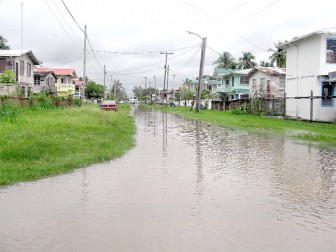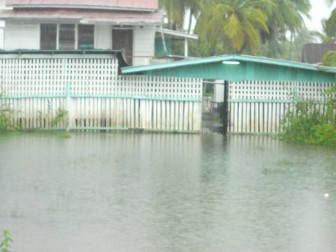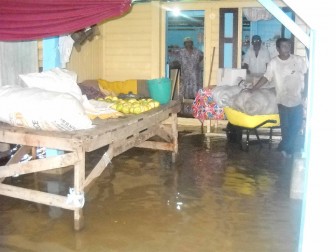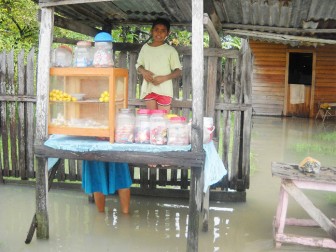Intermittent rain over the weekend resulted in flash flooding throughout most of the country and, with more rain forecast until Friday, inundated East Coast and Georgetown residents fear worst days are ahead.
At a hastily called press briefing yesterday, Agriculture Minister Robert Persaud said his ministry is in “acute emergency mode” and “teams are out in the regions visiting areas” affected by flash flooding. Persaud said the average rainfall since Thursday has been 2.6 inches. However, it was De Kinderen backdam in Region Three which had the highest recorded amount of rainfall at 8.9 inches. According to Persaud, a pump was deployed to the area.

He revealed that the East Demerara Water Conservancy (EDWC) is “getting to a critical point.” The conservancy is being strictly monitored, he stated. He expressed the hope for a break in the weather, which “will allow us not to use the emergency evacuation points.”
The other conservancies are also being monitored. Persaud made the point that this is the fifth occasion that the EDWC has held levels which are greater than the 2005 flood period. There has been no overtopping, he stated, while adding that work has been done to the Crown Dam of the conservancy. However, he pointed out that there is a small dry season before the May/June rains and this will have to be gainfully used to get more works on the conservancy completed.
March is expected to have an average of 10 days of rainfall greater than 1 mm. With La Nina expected to continue until the end of the first quarter of 2011, “wetter than average conditions” are expected, Garvin Cummings, Chief of the Hydrometeorological Service said. According to Cummings, the remainder of the week will see intermittent rainfall but the amount is expected to measure half of 2.6 inches experienced over the past four days.
‘In trouble’

Many areas along the East Coast Demerara, including Turkeyen, Plaisance, Lusignan, Annandale, Buxton/Friendship, Enterprise, Dazzell Housing Scheme, Paradise and Bare Root were under several feet of water, when this newspaper visited yesterday afternoon.
Persaud said a pump would be deployed at Buxton. “If the rain continue falling, we are in trouble,” Buxton businesswoman Daphne Rosamond said yesterday. The Webster Avenue resident said that over the last few weeks, floodwaters have done significant damage to crops and livestock as well as to personal property in the community. She said recently she lost over two dozen chickens and eggs to the flood. While she did not suffer additional losses yesterday, the woman said that she will likely incur more losses if the rain persists and the water does not drain off quickly.
Patricia McCaddy, a Buxton farmer, said water began to accumulate on her land since Friday. She said with the heavy rain on Sunday and yesterday, the volume of water increased significantly. “The water raising all the time,” the frustrated woman said. The floodwater killed some of her livestock yesterday. “One of me pigs drop twelve piglets and four of them dead this morning,” she said.

Trevor Thomas, another Buxton farmer, was busy trying to lift his pigs to higher ground when this newspaper visited his home. Water has been on his land since Friday. Saying that he was one of the biggest farmers in the community, Thomas said that he has invested significantly in his livestock and expressed concern about the well-being of his pigs. While all his pigs were safe, Thomas said that yesterday’s rain has resulted in 14 bags of feed being spoilt.
Flooding, Thomas said, has become a norm in the part of the community where he lives whenever there is intense rain. He believes that the engineers should revisit drainage in the community with assistance from persons within the community. In the meantime, he promised to remain positive and make the best of the situation.

At Beehive yesterday afternoon, farmer Vidishwar Ramkissoon and his elderly parents were busy lifting their agricultural produce to higher ground. Ramkissoon told Stabroek News that since 2005, every time it rains heavily the area floods. “Since 2005 flood, dis happens,” he said, pointing to his inundated yard.
According to Ramkissoon, when water flows from the backdam into the lower areas, the sluice at Greenfield, which drains the area, is not effective. He said that despite efforts to boost the performance of this sluice, the outfall becomes heavy silted quickly. His parents echoed similar sentiments, saying that they have grown accustomed to repeating the ritual whenever it was the rainy season.
“It’s God wuk, meh can’t complain,” an Enterprise woman told Stabroek News yesterday when asked how the floodwaters had affected her. The woman, who asked not to be named, showed this newspaper her flooded bottom flat. Her yard also had almost two feet of water. “This morning [yesterday], 7 o’clock it come up in de yard and about 1 o’clock it start coming in de bottom flat,” she said.
Another Enterprise resident, who declined to give his name, noted that the floodwater raised serious health concerns. “We live in an area, where unfortunately, many people don’t have septic tanks,” the man said. He also noted that the floodwater led to an increase in the mosquitoes.
The man noted that flooding was a frequent occurrence in his village. “There isn’t adequate drainage,” he opined. The resident said that the community had unique drainage issues and consequently needed a sluice that would drain that community specifically.

Also suffering flash flooding were parts of Georgetown. Areas affected included parts of Alberttown, Queenstown, South and North Ruimveldt, East La Penitence and Albouystown, where many of the streets were covered by water.
A common sight was hiked up pants as persons plodded through ankle high water. One resident of Humming Bird Street in Festival City stated that her family had to move upstairs as the water seeped into their bottom flat. “We deh up hey all day when we come down we gah put on we rain boots,” she shared from her veranda.
In another street, a woman, Elizabeth (only name given) with pants pulled up and shoes in hand, was going back to work. Elizabeth noted that it does not take intense rainfall for the area to flood. “Just lil rain suh and this does happen,” she explained.
Many residents who were affected by the flash flooding around the city expressed the belief that it was poor drainage that was the cause. Persaud pointed out that the drainage system in the city was designed to hold 1.5 inches of rainfall.
‘Alertness’
Persaud said too that the National Drainage and Irrigation Authority (NDIA) is working with the Mayor and City Council, which is responsible for the city, to ensure that everything is working. Efforts to contact the City Engineer of the M&CC yesterday for an assessment of the city’s situation were unsuccessful.
The minister said La Nina alert is still in effect and warned of more flash flooding over the course of this week. He also urged persons in low lying areas to take precautions as well as to be vigilant of pump and sluice operators, who may be slacking off. Persaud noted that over the weekend there have been reports of operators who have not operated the pumps and sluices on time. “[There’s] a lot of work we have to do [and] all of us have to keep that state of alertness,” he said.
Also receiving special attention are affected rice farmers, who are expected to harvest soon. Persaud said efforts are underway to provide farmers with fuel for their pumps so that they can drain their lands to ensure a bountiful harvest season. Priority will be given to the rice and sugar crops during this wet season.
The aim, he said, is to save the rice and sugar that is set for harvesting. “All industries are on high alert,” he stated. The price of rice is good and the market favourable, the minister noted, adding “you just have to get it from the fields.”
Meanwhile, Persaud said that while his ministry is doing all it can to ease the situation of flash flooding, “we are under resourced.” He pointed out the need for 15 mobile pumps and 25 excavators, especially for the low lying areas. In the meantime, the NDIA has been dredging outfalls and removing impediments to ensure that the waters can run off quickly.








